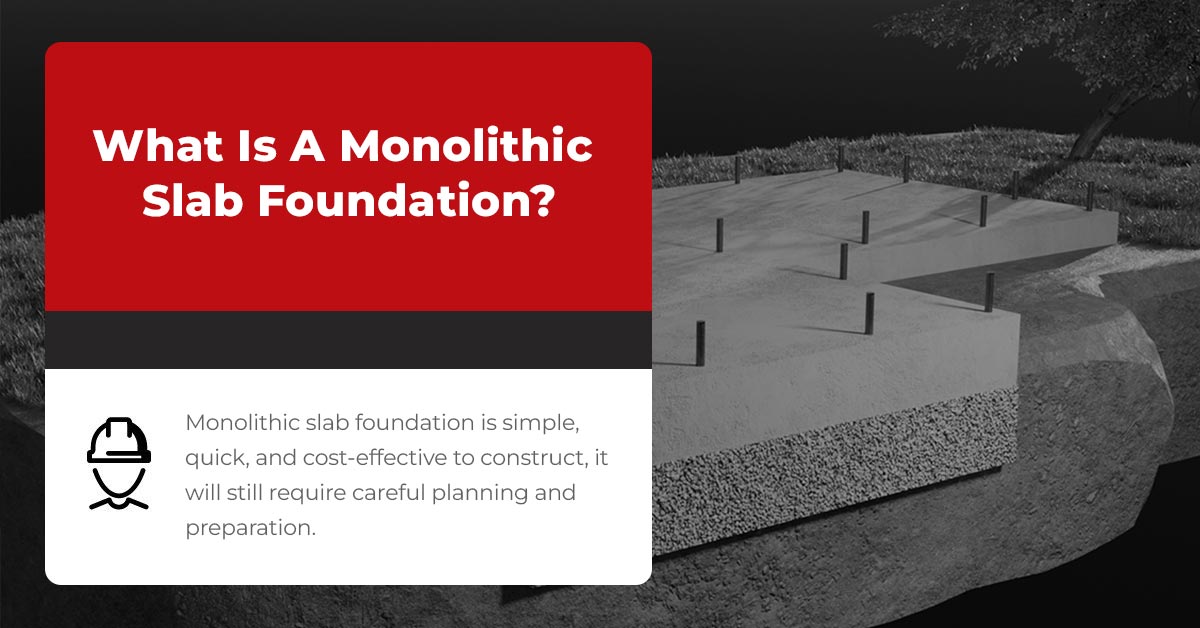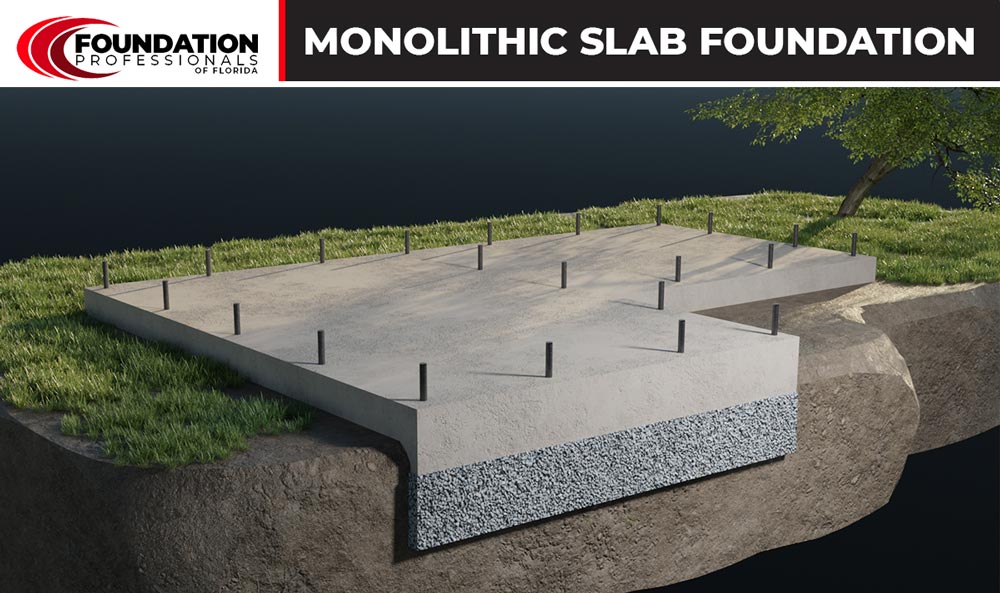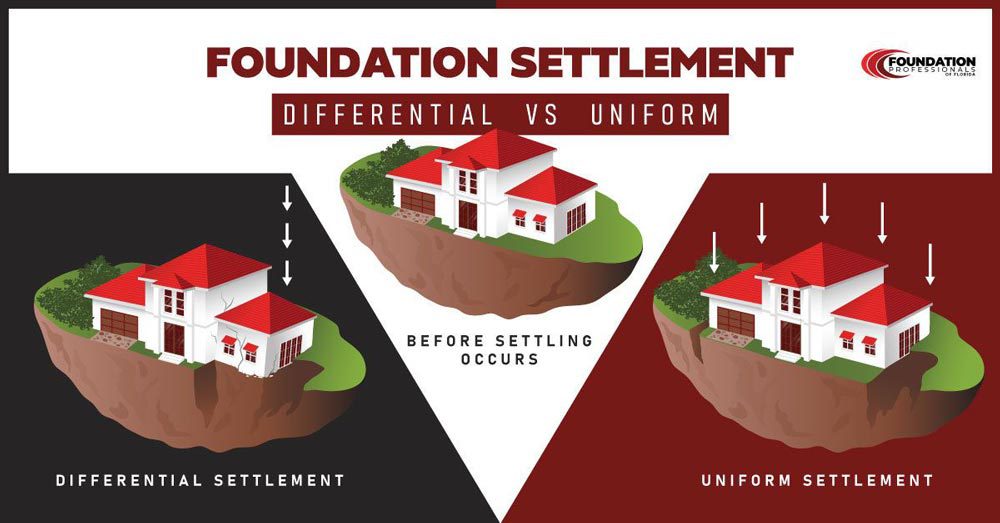Looking for information about monolithic slab foundations? If so, you’ve landed on the right page because that’s what we’re going to review in this article. We’ll review slab-on-grade foundations, the difference between a monolithic slab foundation and a stem wall foundation, the pros and cons of a monolithic slab foundation, and more.
Note: Foundation Professionals of Florida specializes in repairing existing foundations. We do not pour new foundations.
What Are Slab-On-Grade Foundations?
A slab-on-grade foundation is a type of foundation constructed by pouring a thick layer of concrete onto a properly prepared soil surface. The concrete slab is steel reinforced and usually around 4-6 inches thick. A slab-on-grade foundation is a cost-effective option compared to basement and crawl space foundations. Slab-on-grade foundations are common in regions with mild climates with no threat from freeze-thaw cycles.
One benefit of a slab-on-grade foundation is its ability to provide excellent insulation. The thick layer of concrete used in a slab-on-grade foundation helps to regulate temperature and prevent heat loss or gain, providing year-round comfort within the building. Slab-on-grade foundations are also very durable and resistant to damage caused by moisture or pests.
There are two types of slab-on-grade foundations:
- monolithic slab
- stem wall
What Is A Monolithic Slab Foundation?
A monolithic slab foundation is typically poured in one continuous process (all-in-one pour or single-pour foundation), which means there are no joints or seams between the foundation and the floor. This eliminates the risk of water or pests entering the foundation.
The edges of a monolithic slab foundation are typically thicker and have more steel reinforcement than the center of the slab. The thickness of the edge can range from 12 inches to 24 inches, depending on the design and required load capacity.
While monolithic slab foundations are relatively simple, quick, and cost-effective to construct, they still require careful planning and preparation. The soil must be carefully graded and compacted before the foundation is poured. It’s also essential to ensure the foundation is adequately reinforced.
Benefits Of A Monolithic Slab Foundation
Many homeowners and builders prefer monolithic slab foundations for various reasons, including the following:
- Cost-effective and quick to construct – One of the primary benefits of monolithic slab foundations is their cost-effectiveness. Monolithic slab foundations require less excavation and materials than other foundations, making them a more affordable option. They also don’t take very long to build.
- Durable – Because monolithic slab foundations are made from a single concrete slab, there isn’t a lot that could go wrong. They’re also resistant to moisture and pests, making them an ideal choice for areas with high humidity or a lot of insects.
- Energy efficient – Because they’re made of a single layer of concrete, they offer better insulation against the outside temperature, reducing energy consumption and lowering utility bills. Additionally, they’re easy to maintain and clean, requiring little maintenance compared to crawl space and basement foundations.
- Suitable for earthquake-prone regions – Monolithic slab foundations are an excellent choice for areas with high seismic activity. Because they’re a solid, single layer, they’re less susceptible to earthquake damage or cracking.
Downsides Of A Monolithic Slab Foundation
While a monolithic slab foundation is often preferred for its simplicity and cost-effectiveness, it also has several downsides that should be considered. These include the following:
- May not be suitable for larger or more complex structures – Monolithic slab foundations are typically only suitable for buildings with a relatively small footprint and a simple layout. They may not be able to support the weight of larger or multistory buildings. Additionally, a monolithic slab foundation requires a level building site with good soil stability, which may not always be achievable.
- Repairs can be costly – Unlike crawl space foundations where the home’s plumbing and wiring are easy to access, the utilities in a slab foundation are buried in the slab. Repairs will mean breaking up the slab to access them.
- Prone to cracking and settlement – While all foundations are subject to some degree of settlement or movement due to soil conditions and other factors, monolithic slabs may be more vulnerable to cracking or shifting because they are a single piece of concrete. This can lead to structural issues that may be costly and difficult to repair.
- Risk of flooding – Because they sit only around 6 inches off the ground, monolithic slab foundations are at risk of flooding.
What Is A Stem Wall Foundation?
A stem wall foundation is a slab-on-grade foundation with a concrete wall that extends above ground level and supports the rest of the structure. The space is then filled with dirt and compacted. The slab is then poured on top of this compacted dirt. (The term “stem wall” comes from the wall acting as a stem or support for the slab above it.)
Stem wall foundations can be constructed using various materials, including poured concrete, concrete blocks, or brick. The height and thickness of the wall depend on the soil conditions, building codes, and the load-bearing capacity required.
One of the key benefits of using a stem wall foundation is that it provides additional strength and stability to the structure. This is particularly important in areas with high wind or seismic activity, as the stem wall is a barrier to prevent the structure from shifting or becoming damaged. For more information, see What Is A Stem Wall Foundation?
Monolithic Slab Foundations Vs Stem Wall Foundations
Both slab foundation types are designed to provide a stable building base by evenly distributing the structure’s weight across the soil. However, some key differences between monolithic slab and stem wall foundations should be considered when deciding which system is best suited for a particular project.
Different construction methods
One of the primary differences between monolithic slab and stem wall foundations is their construction method. Monolithic slab foundations are formed by pouring a single layer of concrete directly onto the ground. In contrast, stem wall foundations are constructed by pouring a concrete footing and then erecting a wall of concrete blocks on top of the footing. The walls are typically reinforced with steel bars to provide additional strength.
Resistance to soil movement
Another major difference between monolithic slab and stem wall foundations is their resistance to soil movement. Monolithic slab foundations are more susceptible to cracking and shifting due to soil moisture and temperature changes. Stem wall foundations, on the other hand, are better equipped to handle these kinds of movements thanks to their elevated walls and reinforced steel bars.
Monolithic slab foundations are less costly to construct
Monolithic slabs are generally less expensive since they require less material and labor. However, stem wall foundations offer more flexibility in terms of design.
Monolithic Slab Foundation Repair
Like all foundations, monolithic slab foundations can experience differential settlement. This is when a foundation settles into the ground unevenly. Differential settlement places considerable stress on a foundation and if it isn’t promptly repaired, it can lead to serious structural problems.
Fortunately, differential settlement can be repaired using a technique called underpinning. This involves using piers (push, helical, or slab) to extend the foundation down to load-bearing soil. Once the piers are in place, the foundation is raised and leveled.
If you think your home might have a foundation problem, contact Foundation Professionals of Florida today to schedule an evaluation.




